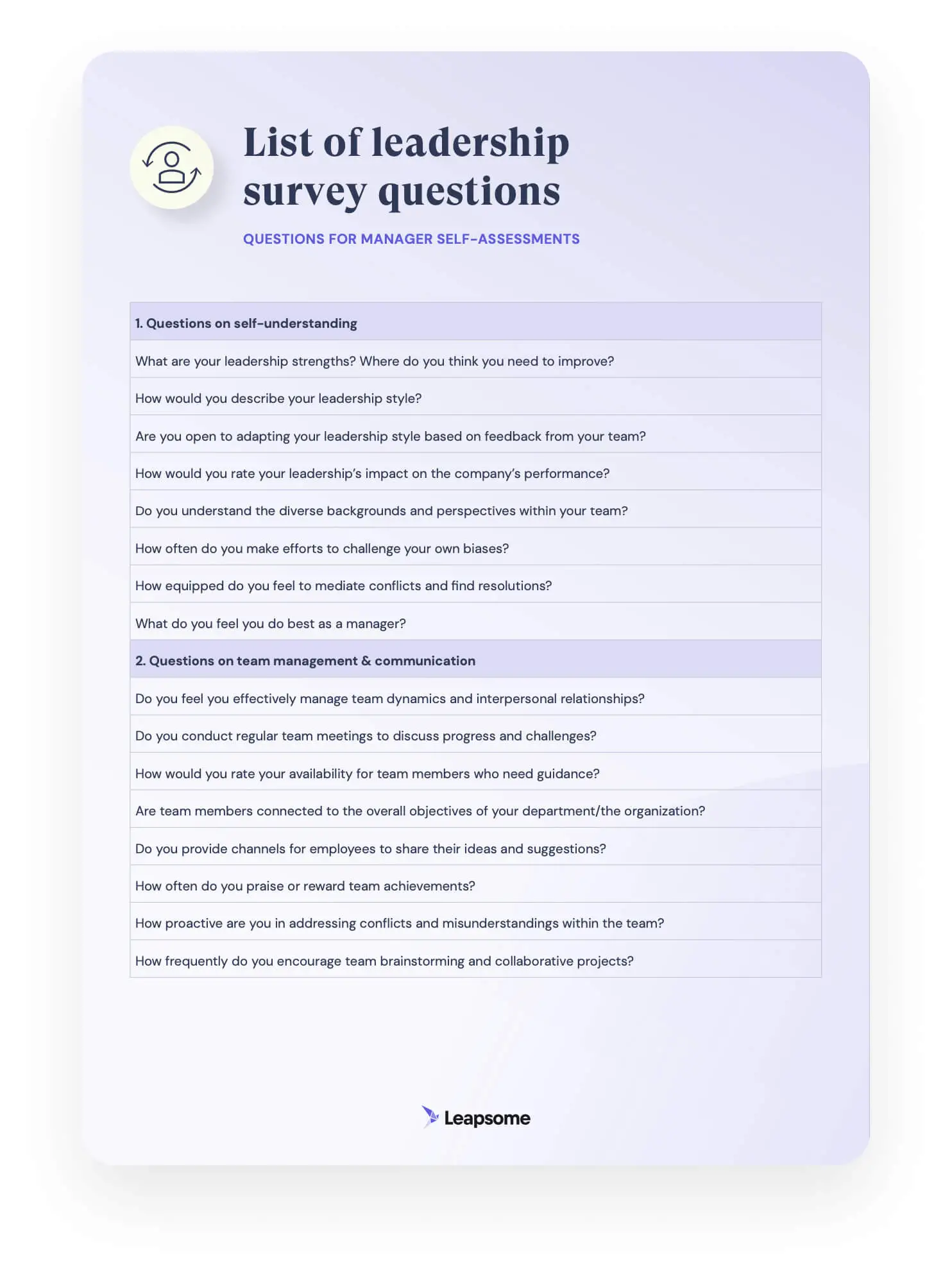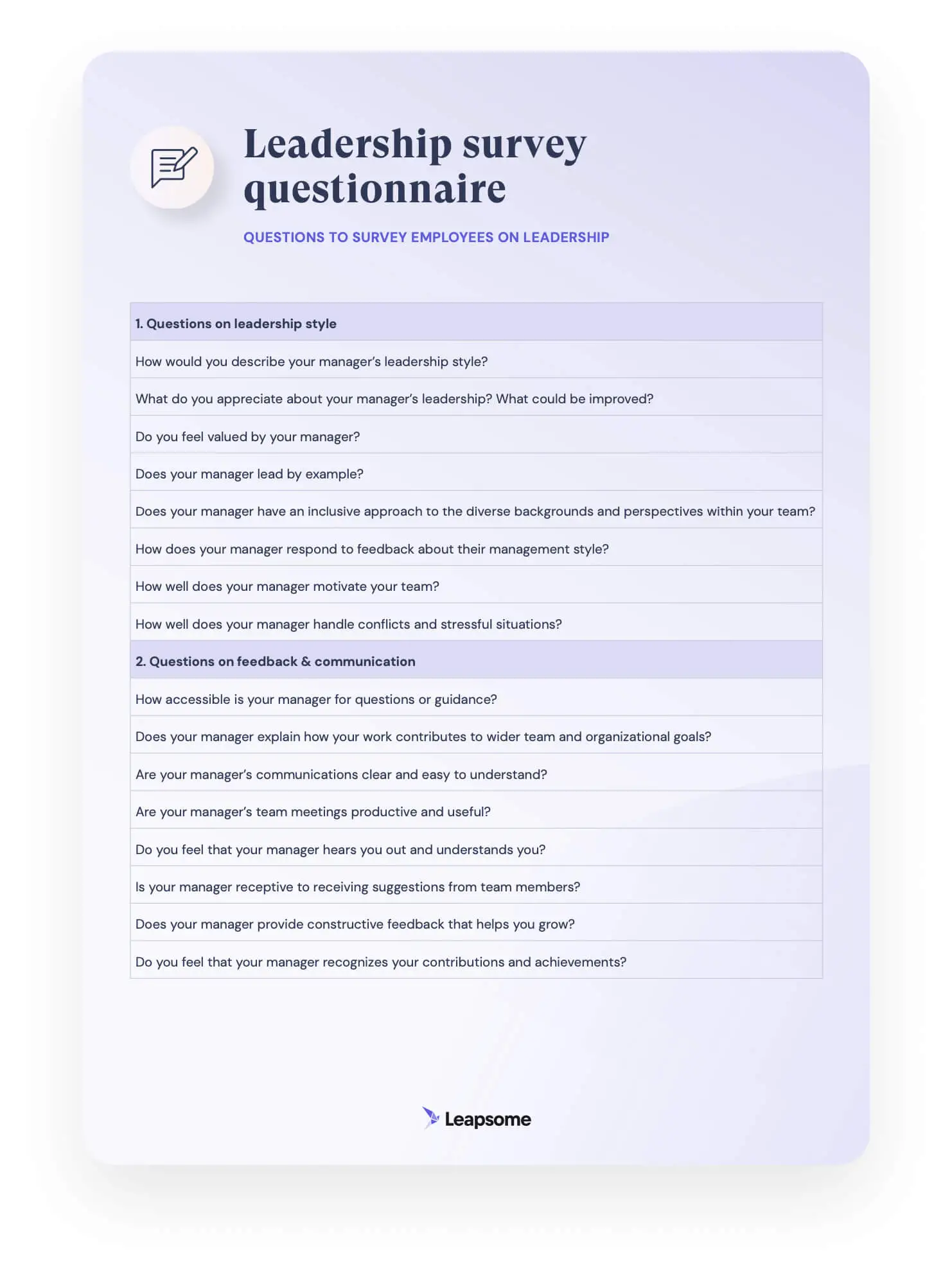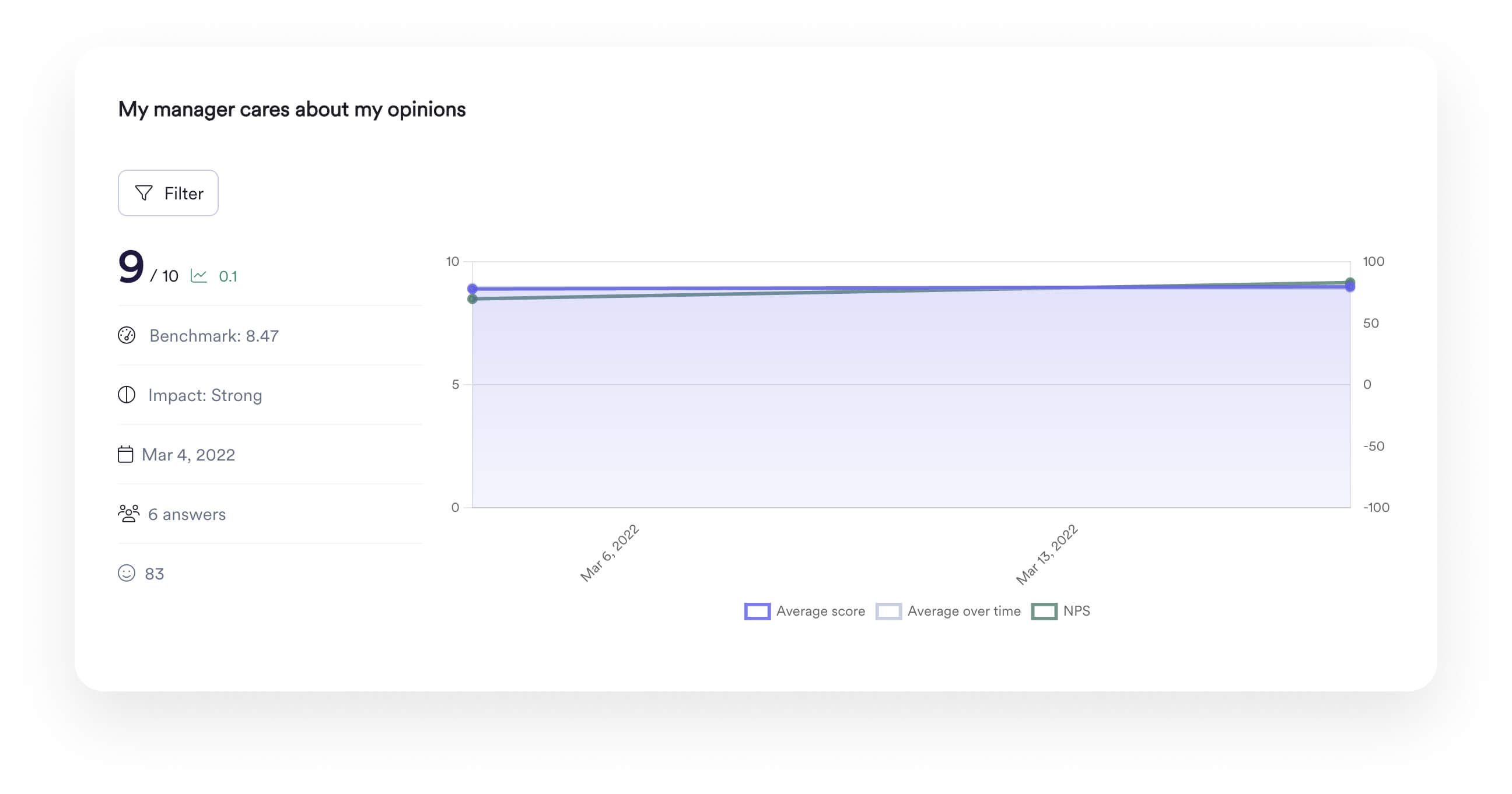64 key leadership survey questions to empower management & employees
.jpg)
HR leaders identify three main reasons for high employee turnover — strained dynamics with managers, uninspiring workplace cultures, and a lack of professional development opportunities. (1)
Strong leadership impacts all of these issues. Great leaders build trust, keep teams engaged, and support learning, making for positive, productive workplaces. Recent research suggests that a striking 70% of team engagement depends on the manager. (2)
Yet how many organizations proactively measure leadership effectiveness? Without meaningful feedback, leaders won’t know how they’re doing and might be unaware of growing issues within the team, causing a disconnect that can impact both employee satisfaction and company success.
That’s why it’s crucial for leaders to do regular self-assessments and seek feedback from their teams. The challenge lies in asking the right questions to uncover truly valuable insights.
That’s why we’ve put together this comprehensive guide to running leadership questionnaires that are truly effective — for both managers and employees. Learn how leadership surveys can improve your business culture and download our free list of questions to get started today.
- Leapsome’s Workforce Trends Report, 2023
- Gallup, 2023
🤝 Bridge gaps between managers and teams
Download our free guide packed with effective survey questions for leaders and team members.
👉 Claim your leadership survey guide
How leadership surveys create a culture of continuous improvement

Feedback is fuel for leadership. In fact, leaders who ranked in the top 10% for seeking feedback were rated much higher (on average, in the 86th percentile) for overall leadership effectiveness in a recent Harvard Business Review study.
Leadership surveys are a structured way to collect that feedback and assess leaders’ impact and capabilities. They pave the way for a company culture that focuses on constant growth and development, benefitting not just managers but teams and organizations as a whole.
Benefits for managers include:
- Insight into blind spots. Surveys provide managers with feedback they may not otherwise receive.
- Team health. Questionnaires can reveal underlying issues that managers can address proactively before they become major problems.
- Personal growth. Focused feedback and self-reflection helps managers identify where to target their professional development efforts. Research shows that when leaders take time to reflect on their leadership qualities, they make more progress on their goals.
- Key performance metrics. It's easier for managers to gauge their effectiveness and decide what to work on when they can visualize and track the data.
There are also employee-specific advantages, such as:
- Voice and visibility. Surveys give team members a structured channel where they can express their thoughts and concerns.
- Clear expectations. Feedback systems let teams share what they expect from leadership. Leapsome’s Workforce Trends Report shows that three in four employees want more feedback and recognition from their managers. Knowing these expectations can help leaders shape their roles around employee needs.
- Culture of growth. When employees observe leaders proactively seeking out feedback, it instills an ethos of continuous improvement that encourages them to prioritize their own development.
- Job satisfaction. 74% of professionals say that when they feel heard, they’re more satisfied and more effective at work. Seeing managers enact change based on the feedback they receive is highly motivating.
🔄 Close the feedback loop with Leapsome
Enhance your survey strategy with customizable templates, data analysis, and visualization tools, all in one place.
👉 Learn more
Free download: 64 questions for insightful leadership surveys

By asking the right questions of themselves and their direct reports, managers can get a well-rounded assessment. This will help them to understand themselves and their leadership styles and take action to develop particular skills, qualities, and behaviors — which will improve the manager-employee relationship in turn.
💬 “Surveys can show how to fix things, which benefits both managers and teams. But I’ve also found it important to make sure surveys leave space to credit those in leadership positions for things they’re doing well, to recognize their efforts and show them what’s working.”
— Apurva Pawar, Human Capital Manager at SiftHub

Strong leadership surveys should include a range of different question types. Build out your questionnaires with a mix of open and closed questions and vary the topics you focus on.
You can start by customizing our list of questions to make sure you cover all the bases.
🎯 Create a culture of informed leadership
Get our free guide with top survey questions to understand and improve managerial impact.
👉 Download now
32 leadership survey questions for effective manager self-assessments
Improving leadership starts with managers reflecting honestly on their performance across different aspects of their role.
Make sure your leaders understand that the purpose of these surveys isn’t to criticize or judge them for any perceived shortcomings — it’s to help them to develop, as well as recognizing their achievements.
Candid self-assessments are fuel for managers’ personal and professional growth.
Questions on self-understanding
To lead effectively, it's essential to first understand yourself. These questions help managers improve their self-awareness to grow as professionals.
1. What are your leadership strengths? Where do you think you need to improve?
2. How would you describe your leadership style?
3. Are you open to adapting your leadership style based on feedback from your team?
4. How would you rate your leadership’s impact on the company’s performance?
5. Do you understand the diverse backgrounds and perspectives within your team?
6. How often do you make efforts to challenge your own biases?
7. How equipped do you feel to mediate conflicts and find resolutions?
8. What do you feel you do best as a manager?
Questions on team management & communication
These survey questions help leaders reflect on their strengths and weaknesses in team building and communication for effective, collaborative workplaces.
9. Do you feel you effectively manage team dynamics and interpersonal relationships?
10. Do you conduct regular team meetings to discuss progress and challenges?
11. How would you rate your availability for team members who need guidance?
12. Are team members connected to the overall objectives of your department/the organization?
13. Do you provide channels for employees to share their ideas and suggestions?
14. How often do you praise or reward team achievements?
15. How proactive are you in addressing conflicts and misunderstandings within the team?
16. How frequently do you encourage team brainstorming and collaborative projects?
Questions on performance & decision-making
Leaders make critical decisions daily. These questions guide them in honing their decision-making skills to make the most positive impact possible on their team and organization.
17. How have you progressed on your key goals this quarter?
18. Do you feel you set clear, measurable performance expectations for your team?
19. Do you use data and feedback to guide your decisions?
20. How often do you review and adjust performance strategies?
21. How do you handle projects or decisions that don’t go well?
22. Do you involve your team in decision-making processes?
23. Do you promote a culture of continuous improvement and innovation?
24. What would support you in improving your team’s performance?
Questions on training, development & innovation
Leaders can use these questions as a compass to make sure they’re pointing their team toward growth and innovation.
25. How do you identify your team members’ training and development needs?
26. How do you measure the effectiveness of your team’s training and development? Do you actively seek and incorporate employee feedback?
27. Are there clear career development paths for your team members within the organization?
28. What resources are available for employees to expand their knowledge and skills?
29. How do you encourage and support mentorship and knowledge-sharing within your team?
30. What steps do you take to foster a culture of innovation and creative thinking?
31. What strategies do you use to stay updated on industry trends and best practices?
32. How do you incentivize and recognize innovative ideas and contributions from your team?
32 questions for employees to voice leadership feedback
A well-crafted leadership survey provides a structured space where employees can offer candid feedback on how their managers are performing.
Understanding your team’s perceptions lets you identify the biggest leadership gaps. You can then build an effective strategy for your managers’ professional development while celebrating their strengths.
Ideally, you should repeat some of the questions from your leadership self-assessments so you can compare employee answers and see where perspectives differ.
The following questions can be tailored to fit the unique context of your organization.
Questions on leadership style
These questions aim to uncover key insights on how employees perceive their manager’s approach to leadership — which might differ from how managers view themselves.
1. How would you describe your manager’s leadership style?
2. What do you appreciate about your manager’s leadership? What could be improved?
3. Do you feel valued by your manager?
4. Does your manager lead by example?
5. Does your manager have an inclusive approach to the diverse backgrounds and perspectives within your team?
6. How does your manager respond to feedback about their management style?
7. How well does your manager motivate your team?
8. How well does your manager handle conflicts and stressful situations?
Questions on feedback & communication
Understanding how employees feel about communication can promote open, transparent workplace discussions. Ask questions such as:
9. How accessible is your manager for questions or guidance?
10. Does your manager explain how your work contributes to wider team and organizational goals?
11. Are your manager’s communications clear and easy to understand?
12. Are your manager’s team meetings productive and useful?
13. Do you feel that your manager hears you out and understands you?
14. Is your manager receptive to receiving suggestions from team members?
15. Does your manager provide constructive feedback that helps you grow?
16. Do you feel that your manager recognizes your contributions and achievements?
Questions on performance & decision making
Seeking employee perspectives on different aspects of performance will help managers to make informed decisions and improve team results.
17. Does your manager set clear, achievable goals and performance expectations?
18. On a scale of 1 to 10, how transparent is the decision-making process?
19. Does your manager seek team input before making a major decision?
20. Does your manager analyze data and facts before making decisions?
21. Does your manager take responsibility for their decisions and acknowledge their mistakes?
22. Does your manager effectively tackle performance issues?
23. Is your manager good at allocating resources efficiently?
24. Does your manager regularly share and review results on team goals?
Questions on training, development & innovation
These questions help leaders understand how team members feel about their current learning opportunities, so they can prioritize employee development and build a culture of continuous improvement.
25. How would you rate the quality and frequency of feedback you receive from your manager?
26. Does your manager encourage you to set and achieve career goals?
27. Does your manager regularly review and discuss your performance development plan with you?
28. Are the organization’s training programs tailored to your team and individual needs?
29. How effective is your manager at coaching and mentoring?
30. Is innovation recognized and rewarded within your team?
31. Does your manager provide stretch goals to help you grow?
32. Is your team given the necessary time and resources to experiment with new ideas?
💡Gain meaningful perspectives on leadership
Use our free survey question template to help your managers gather valuable insights and develop their leadership skills.
👉 Get it here
Tips to conduct leadership surveys with impact
There’s a lot that goes into designing leadership surveys that drive real organizational change. The success of your questionnaires depends not only on the questions you include, but on how well you roll it out and analyze the survey responses.
Here are a few best practices to help you take a strategic approach to gathering actionable insights from both managers and employees:
- Define clear objectives — Before you start, determine what you want to achieve with your surveys. Is it to identify areas for managerial improvement, to understand employee satisfaction with leadership, or to gauge the effectiveness of your leadership training? Different goals require different strategies.
As HR expert and Owner of Culture x Code Consulting Carly Pomeroy explains: “The key is to ask why you’re running the survey in the first place. You need to have buy in on the WHY. The process is most effective when managers can identify goals they hope to achieve. If managers or leadership aren’t prepared to act on the feedback, you won’t get much out of your survey.”
- Keep it short and focused — Design the questionnaire to be completed in 15 to 20 minutes to make it easier for busy team members to fill out. Avoid jargon and keep the language simple and direct.
- Make it accessible — Use an accessible, easy-to-read font and make sure it’s easy to complete the questionnaire on different devices including mobile phones, tablets, and desktops.
- Increase adoption — Send reminders to boost participation (but keep them limited). Clearly communicate the survey deadline and make sure it’s in your team’s calendars. Motivate employees to respond by explaining clearly how their feedback will be used to improve leadership and build a better work environment, as well as giving them an opportunity to have their voice heard.
- Keep it anonymous — You’ll likely get more honest, uninhibited responses from employee surveys if they’re anonymous. Make it clear that the data will be confidential and protected.
- Include identical questions — Cover overlapping topics in the employee survey questions and the self-assessment questions for managers. Discrepancies in how the two groups answer the same question could reveal important blind spots — perhaps leaders rate themselves highly for communication skills, but that’s not reflected in employee perceptions of conversations and meetings.
- Make a plan for data analysis — Make a strategy for analyzing your survey data. You may want to segment it by department, team, or role, and use a dedicated tool to interpret and visualize the results. For example, you could map out employee sentiment using text analysis software or create charts to show scores on ranking questions. Leapsome can help you do both!
- Decide what you’ll do with the results — You may want to communicate sensitive results with certain managers confidentially, while you might share general organizational leadership results more widely. Incorporate key insights into leadership performance reviews. Make sure you use the survey responses to recognize their strengths and support them to build key competencies for empowering leadership. You should also encourage managers to close the feedback loop, showing employees they’ve heard their thoughts by telling them how they plan to take action.

Use Leapsome to get actionable insights from leadership surveys

Leadership surveys are essential HR tools that can help managers reach their full potential and give employees a voice on what they need from your leadership team.
To turn leadership feedback into an effective action plan, you’ll need to dig deep into your data, analyzing survey responses to spot trends and map out related goals.
Leapsome’s holistic people enablement platform makes it easy to collect and interpret the feedback you need to empower your leaders.
Our Surveys module includes customizable, expert-backed templates and survey automation tools to streamline your leadership questionnaires. Powerful analytics features let you segment responses and even turn qualitative data like employee sentiment into easy-to-understand visualizations.
Use our Reviews module to design and implement an actionable, continuous approach to leadership performance assessments with adaptable questions, timelines, reminders, and anonymity settings.
Last, our Competency Framework feature helps managers grow by mapping out key leadership competencies and aligning them with goal setting and feedback processes.
Because choosing Leapsome means investing in effective leaders, empowered teams, and a culture of transformational, continuous improvement.
🚀 Help leaders reach their full potential
Leapsome is your all-in-one platform for people, performance, and progress.
👉 Request a demo
Sind Sie bereit, Ihre Strategie zur Mitarbeiterförderung zu verbessern?
your People operations?
Informieren Sie sich über unsere Leistungsbeurteilungen, Ziele und OKRs, Engagement-Umfragen, Onboarding und mehr.
.webp)
.webp)
 Fordern Sie noch heute eine Demo an
Fordern Sie noch heute eine Demo an































